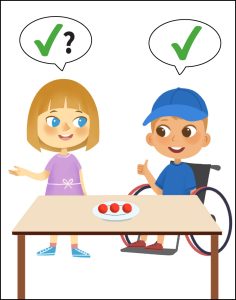 Three-year-olds Adele and Mateo are taking turns rolling a number cube to figure out how many pretend chocolate chips they need to place on their cookie board. Adele rolls a 3, counts out the chocolate chips, and places them on a separate checking plate. Next, Mateo counts the chocolate chips on the checking plate to verify for accuracy, but he counts only two chocolate chips. Together, Adele and Mateo realize they needed to add one more chocolate chip from the plate to match the number rolled on the number cube. This “checking” step might seem unnecessary, but when paired with skills children are still learning, an intermediate step may support the development of counting and addition skills, as well as executive function skills. [The activity described here is from the DREME Guided Small Group Math Activity: Cookie Game]
Three-year-olds Adele and Mateo are taking turns rolling a number cube to figure out how many pretend chocolate chips they need to place on their cookie board. Adele rolls a 3, counts out the chocolate chips, and places them on a separate checking plate. Next, Mateo counts the chocolate chips on the checking plate to verify for accuracy, but he counts only two chocolate chips. Together, Adele and Mateo realize they needed to add one more chocolate chip from the plate to match the number rolled on the number cube. This “checking” step might seem unnecessary, but when paired with skills children are still learning, an intermediate step may support the development of counting and addition skills, as well as executive function skills. [The activity described here is from the DREME Guided Small Group Math Activity: Cookie Game]
What Are Intermediate Steps in Math Activities?
An intermediate step results from breaking down a task or problem into smaller, manageable steps. Intermediate steps are a form of scaffolding that can be used in various ways. For example, intermediate steps could involve prompting children to check their work, try a new strategy, or slow down when solving a problem.
Why Are Intermediate Steps Important?
It may be tempting to skip over intermediate steps to shorten time spent on the activity, but there are many reasons to keep them:
- Intermediate steps give children an opportunity to slow down, reflect on what math they are doing, and check their work. These behaviors offer opportunities to practice math and executive function (EF) skills. EF skills allow people to think about and control their behaviors and thoughts.
- Slowing down to check their work or think through a problem can help children notice their own or their partner’s mistakes, like Adele and Mateo did in the vignette. Catching mistakes can promote mathematical thinking and problem solving.
- Checking your work is a habit that children can use in later math.
- Some children might already be used to checking their work on their own. But children who are struggling with or still learning a skill might benefit from being prompted to slow down and deliberately check their work.
- Teachers can benefit from observing how children reason or practice math skills during intermediate steps. For example, observations can reveal which math concepts a child is still learning versus which concepts they seem to understand well.
For more examples and tips for using intermediate steps in math activities, see the DREME Guided Small Group Math Activity: Big Fish Story, in which a checking plate is described as a “pool.”
Further Information: